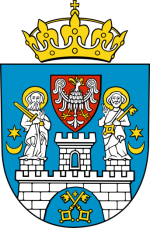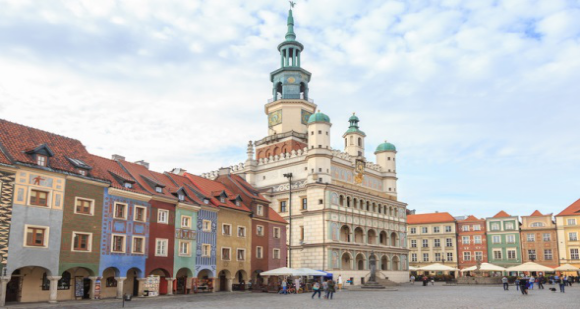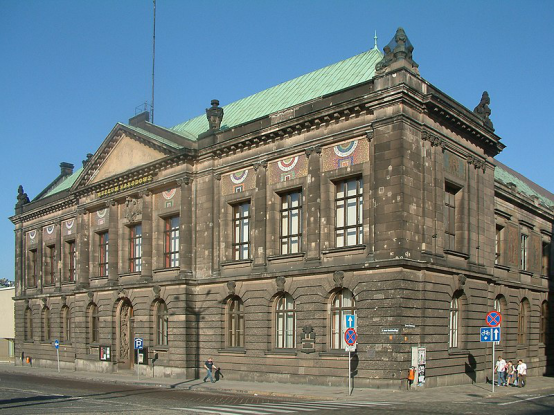Poznań- Greater Poland 作者: 来源: 发布时间:2021-03-05
Ⅰ. Population and Area
Country Poland
Voivodeship Greater Poland Voivodeship
County city county
Area
• City 261.85 km2 (101.10 sq mi)
Population (31 December 2019)
• City 534,813 Decrease
• Urban 1.1 million
• Metro 1.4 million

Website www.poznan.pl
Ⅱ.Natural Geography (environment and resources)
- Poznań covers an area of 261.3 km2 (100.9 sq mi), and has coordinates in the range 52°17'34''–52°30'27''N, 16°44'08''–17°04'28''E. Its highest point, with an altitude of 157 m (515 ft), is the summit of Góra Moraska (Morasko Hill) within the Morasko meteorite nature reserve in the north of the city. The lowest altitude is 60 m (197 ft), in the Warta valley.
- Poznań's main river is the Warta, which flows through the city from south to north. As it approaches the city centre it divides into two branches, flowing west and east of Ostrów Tumski (the cathedral island) and meeting again further north. The smaller Cybina river flows through eastern Poznań to meet the east branch of the Warta (that branch is also called Cybina – its northern section was originally a continuation of that river, while its southern section has been artificially widened to form a main stream of the Warta). Other tributaries of the Warta within Poznań are the Junikowo Stream (Strumień Junikowski), which flows through southern Poznań from the west, meeting the Warta just outside the city boundary in Luboń; the Bogdanka and Wierzbak, formerly two separate tributaries flowing from the north-west and along the north side of the city centre, now with their lower sections diverted underground; the Główna, flowing through the neighbourhood of the same name in north-east Poznań; and the Rose Stream (Strumień Różany) flowing east from Morasko in the north of the city. The course of the Warta in central Poznań was formerly quite different from today: the main stream ran between Grobla and Chwaliszewo, which were originally both islands. The branch west of Grobla (the Zgniła Warta – "rotten Warta") was filled in late in the 19th century, and the former main stream west of Chwaliszewo was diverted and filled in during the 1960s. This was done partly to prevent floods, which did serious damage to Poznań frequently throughout history.
- Transport
- Poznań has an extensive public transport system, mostly consisting of trams, such as the Poznań Fast Tram, and both urban and suburban buses. The main railway station is Poznań Central Station to the southwest of the city centre; there is also the smaller Poznań Wschód and Poznań Garbary station northeast of the centre and a number of other stations on the outskirts of the city. The main east-west A2 motorway runs south of the city connecting it with Berlin in the west and Łódż and Warsaw in the east; other main roads run in the direction of Warsaw, Bydgoszcz, Wągrowiec, Oborniki, Katowice, Wrocław, Buk and Berlin. Poznań has one of the biggest airports in the west of Poland called Poznań-Ławica Airport. In 2016 it handled approximately 1.71 million passengers.
Ⅲ.Economy
- Poznań has been an important trade centre since the Middle Ages. Starting in the 19th century, local heavy industry began to grow. Several major factories were built, including the Hipolit Cegielski steel mill and railway factory (see H. Cegielski - Poznań S.A.).
- Nowadays Poznań is one of the major trade centres in Poland. Poznań is regarded as the second most prosperous city in Poland after Warsaw. The city of Poznań produced PLN 31.8 billion of Poland's gross domestic product in 2006. It boasts a GDP per capita of 200.4% (2008) of Poland's average. Furthermore, Poznań had very low unemployment rate of 2.3% as of May 2009. For comparison, Poland's national unemployment rate was over 10%.
- Andersia Tower (left) and Poznań Financial Centre (right)
- Many Western European companies have established their Polish headquarters in Poznań or in the nearby towns of Tarnowo Podgórne and Swarzędz. Most foreign investors are German and Dutch companies, with a few others. The best known examples of corporation who have their headquarters in Poznań and the surrounding areas are that of GlaxoSmithKline, Raben Group (near Kórnik) and Kuehne + Nagel (near Gądki).
- Investors are mostly from the food processing, furniture, automotive and transport and logistics industries. Foreign companies are primarily attracted by low labour costs and by the relatively good road and railway network, good vocational skills of workers and relatively liberal employment laws.
- The recently built Stary Browar shopping centre contains many high-end shops and is considered one of the best in Europe. It has won an award for the best shopping centre in the world in the medium-sized commercial buildings category. Other notable shopping centres in the city include Galeria Malta, one of the largest in Central Europe, and the shops at the Hotel Bazar, a historical hotel and commercial centre in the Old Town.
- Some of the best-known major corporations founded and still based in Poznań and the city's metropolitan area include Allegro, Poland's biggest online auction site, H. Cegielski-Poznań SA, a historic manufacturer, Solaris Bus & Coach, a modern bus and coach maker based in Bolechowo and Enea S.A., one of the country's biggest energy firms. Poznań is also where the software development leader Netguru was founded, one of the fastest growing companies in Europe. Kompania Piwowarska based in Poznań produces some of Poland's best known beers, and includes not only the local Lech Brewery but also Tyskie from Tychy and Dojlidy Brewery from Białystok among many others.
Poznan – June 2020
Population (as of 31 XII 2019) 534 813 ↓
Average monthly gross wages
and salaries in enterprise sector 5 676,05 zł ↑
Registered unemployed persons 1,7% ↑
Dwellings completed (I–VI 2020) 1 755* ↓
Dynamics of sold production of industry 100,2**
Dynamics of construction and assembly production 87,0**
National economy entities 116 843 ↑
*Preliminary data
**Corresponding period of previous year = 100
Statistical Office in Poznan / Poznan https://poznan.stat.gov.pl/en/poznan/
Ⅳ.Industrial Characteristics
- Poznań is a place where the energy of the New Europe is merged with the civilization of the West. A metropolis with over half-a-million residents, Poznań is situated in the most economically developed region of Poland, closer to Berlin than to Warsaw. Poznanians can be counted on - they are well-educated, competent and welcoming.
- The city is focused on achieving success, grounded on a 1000-year tradition of competence. The most ambitious of projects and the bravest of visions have a chance to succeed here. The state of Poland was born in Poznań and it was also the location of the Greater Poland Uprising, the only successful armed bid for independence in Poland and a proof of the exceptional resourcefulness of its citizens.
- Poznań is an important center of industry, trade, logistics and business tourism. Poznań is also the academic, scientific and cultural center. The city is one of the largest economic centers in the country. In 2011, the gross domestic product (GDP) produced in Poznan amounted to 42.1 billion zł, which placed for fifth place in the country. In 2011 Poznań produced 2.8% of Polish GDP, which also made for 29.5% of the GDP generated in Wielkopolska.
- The unemployment rate in Poznań is among the lowest in the country. At the end of 2015, the unemployment rate in the city amounted to 2.4%.
- In 2005, the city was among the most attractive places to invest in Poland. According to information provided by the investors, it is estimated that the value of accumulated foreign direct investment in the period 1990-2010 was in Poznan 6.6 billion $.
- According to external assessments carried out by the rating agency Moody's Investors Service, in terms of credibility for investors Poznań slightly gives way to a much larger Warsaw. In March 2013 the city once again received an assessment of A3 with a stable outlook. It means that Poznań has a very high capacity to meet its financial obligations and credibility should not be changed in the near future. In November 2013 Poznań has got the credibility of the financial agency Fitch Ratings at A- with a stable outlook. Since 2006 rating city has remained unchanged.
- In 2014, in Poznań were registered 107 117 businesses, including 68 699 natural persons conducting individual economic activity.
- Poznań is dominated by companies operating in the field:
- trade and repairs
- professional, scientific and technical
- construction
- industrial processing
- other services
- health care and social assistance
- transportation and warehousing
- The high number of SMEs has lead to an increased demand for professional consultancy services. In Poznań, apart from commercial consultancy companies there are many non-governmental non-profit organisations which provide access to business information and professional consultancy toa vast group of customers. In this regard it is worth noting organisations that are associated in the National SME Services Network (KSU), whose main objective is to raise the competitiveness of Polish companies by providing them with a comprehensive offer of high quality training and advisory services. These organisations include: the Wielkopolska Chamber of Crafts in Poznań, the Polish Economic Chamber of Importers, Exporters and Cooperation, the Chamber of Industry and Commerce of the Wielkopolska Region, the Wielkopolska Club of Technology and Rationalisation and the Association of Innovation and Entrepreneurship Centres in Poland as well as research institutions such as the Institute of Logistics and Warehousing and the Wood Technology Institute.
- The growth of entrepreneurship is one of the priorities of the Poznań authorities who have undertaken various activities aimed at assisting the owners of small and medium enterprises in operating their businesses. These activities include the establishing of the Poznań Fund of Loan Guarantees33, to provide professional training to prospective and active businesspeople as well as to promote successful enterprises from the SME sector (e.g. the Enterprise Leader competition). The city authorities have also created a Business Information Point and are working on the Poznań Incubator of Advanced Technologies project. In 2003, Poznań institutions which support entrepreneurs agreed to cooperate in the field of developing the local network of entrepreneurship-related services within the Entrepreneurship and Employment Support Network.
- From 2012 Training and Advisory Centre has been running. It is managed by employees of Department of Business Activity and Agriculture, Poznan City Hall. It is placed: ul. 28 Czerwca 1956 r. nr 404, 61-441 Poznań.
- The mian aim of the Centre is supporting prospective and existing entrepreneurs.
- It provides wide range of services, such as: individual counseling, regular training and workshops. All of its activity is free of charge. You can find more details here at www.poznan.pl/poznanbiznespartner
- Key Project
1. Beyond.pl is Expanding the Poznań Campus. The New Data Center to Reach 42MW
Invest in Poznan - Poznan.pl https://www.poznan.pl/mim/inwestycje/en/
2. City of Poznan investment offer in 2020 - strategic areas
City of Poznan investment offer in 2020 - strategic areas - News - Invest in PoznanPoznan.pl https://www.poznan.pl/mim/inwestycje/en/news/city-of-poznan-investment-offer-in-2020-strategic-areas,146128.html
Ⅴ.Attrations and Cityscape
- Poznań has many historic buildings and sights, mostly concentrated around the Old Town and other parts of the city centre. Many of these lie on the Royal-Imperial Route in Poznań – a tourist walk leading through the most important parts of the city showing its history, culture and identity. Portions of the city centre are listed as one of Poland's official national Historic Monuments (Pomnik historii), as designated 28 November 2008, along with other portions of the city's historic core. Its listing is maintained by the National Heritage Board of Poland.

Old Market Square

National Museum in Poznan
Ⅵ.History and Culture
- For centuries before the Christianization of Poland, Poznań (consisting of a fortified stronghold between the Warta and Cybina rivers, on what is now Ostrów Tumski) was an important cultural and political centre of the Polan tribe. Mieszko I, the first historically recorded ruler of the Polans, and of the early Polish state which they dominated, built one of his main stable headquarters in Poznań. Mieszko's baptism of 966, seen as a defining moment in the Christianization of the Polish state, may have taken place in Poznań.
- In about 1249, Duke Przemysł I began constructing what would become the Royal Castle on a hill on the left bank of the Warta. Then in 1253 Przemysł issued a charter to Thomas of Guben (Gubin) for the founding of a town under Magdeburg law, between the castle and the river. Thomas brought a large number of German settlers to aid in the building and settlement of the city – this is an example of the German eastern migration (Ostsiedlung) characteristic of that period.[11][12] The city (covering the area of today's Old Town neighbourhood) was surrounded by a defensive wall, integrated with the castle. According to Walter Kuhn, in 1400 three-quarters of the town's population was German-speaking
- At the end of World War I, the final Greater Poland Uprising (1918–1919) brought Poznań and most of the region back to newly reborn Poland, which was confirmed by the Treaty of Versailles. The local German populace had to acquire Polish citizenship or leave the country. This led to a wide emigration of the ethnic Germans of the town's population.[citation needed] The town's German population decreased from 65,321 in 1910 to 5,980 in 1926 and further to 4,387 in 1934. In the interwar Second Polish Republic, the city again became the capital of Poznań Voivodeship. Poznań's university (today called Adam Mickiewicz University) was founded in 1919, and in 1925 the Poznań International Fairs began. In 1929 the fairs site was the venue for a major National Exhibition (Powszechna Wystawa Krajowa, popularly PeWuKa) marking the tenth anniversary of independence; it attracted around 4.5 million visitors. The city's boundaries were again expanded in 1925 (to include Główna, Komandoria, Rataje, Starołęka, Dębiec, Szeląg and Winogrady) and 1933 (Golęcin, Podolany).
- The most recent expansion of the city's boundaries took place in 1987, with the addition of new areas mainly to the north, including Morasko, Radojewo and Kiekrz. The first free local elections following the fall of communism took place in 1990. With the Polish local government reforms of 1999, Poznań again became the capital of a larger province (Greater Poland Voivodeship). It also became the seat of a powiat ("Poznań County"), with the city itself gaining separate powiat status.
- Recent infrastructural developments include the opening of the fast tram route (Poznański Szybki Tramwaj, popularly Pestka) in 1997, and Poznań's first motorway connection (part of the A2 autostrada) in 2003. In 2006 Poland's first F-16 Fighting Falcons came to be stationed at the 31st Air Base in Krzesiny in the south-east of the city.
- Poznań continues to host regular trade fairs and international events, including the United Nations Climate Change Conference in 2008. It was one of the host cities for UEFA Euro 2012.
Ⅶ.Other Information
- Poznań is the fifth-largest and one of the oldest cities in Poland. The city's population is 538,633 (2011 census), while the continuous conurbation with Poznań County and several other communities is inhabited by almost 1.1 million people. The Larger Poznań Metropolitan Area (PMA) is inhabited by 1.3–1.4 million people and extends to such satellite towns as Nowy Tomyśl, Gniezno and Września, making it the fourth largest metropolitan area in Poland. It is the historical capital of the Greater Poland region and is currently the administrative capital of the province called Greater Poland Voivodeship.
- Poznań is a center of trade, sports, education, technology and tourism. It is an important academic site, with about 130,000 students and Adam Mickiewicz University, the third largest Polish university. Poznań is also the seat of the oldest Polish diocese, now being one of the most populous archdioceses in the country. The city also hosts the Poznań International Fair – the biggest industrial fair in Poland and one of the largest fairs in Europe. The city's most renowned landmarks include Poznań Town Hall, the National Museum, Grand Theatre, Fara Church, Poznań Cathedral and the Imperial Castle.
Ⅷ.Contact Information
Mayor Jacek Jaśkowiak (PO)
Tel and E-mail:
61 646 33 44
mim@man.poznan.pl
prezydent@um.poznan.pl
主页-bip.poznan.pl https://bip.poznan.pl/bip/
